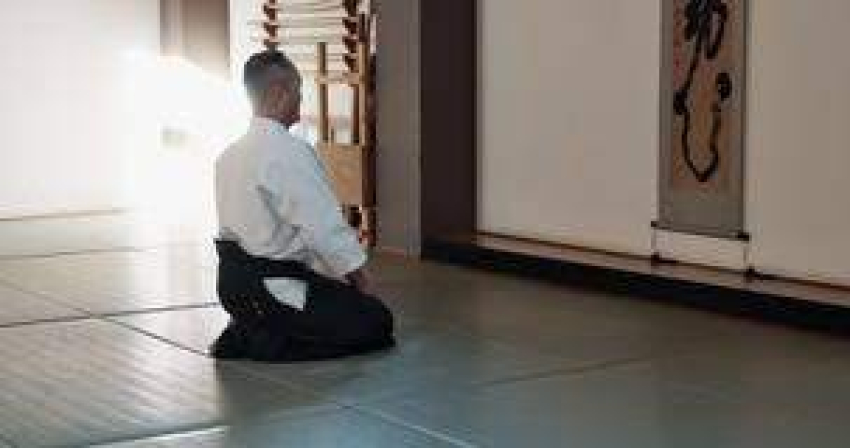(Dojo) قوانین و آداب دوجو:

چگونه تمرینات هنرهای رزمی سنتی دانش آموزان را توانمند می کند.
کاراته از ژاپن رایج شد و به این ترتیب ذاتاً مملو از زبان فرهنگ، لباس های آموزشی،
ابزار و شیوه های اخلاقی است.
ما احساس میکنیم که گنجاندن بسیاری از این سنتها نه تنها برای تقویت تجربه آموزشی دانشآموزان یا تقویت قدردانی فرهنگی،
بلکه کمک به آنها برای توسعه نظم و انضباط و احترام به خود بسیار ارزشمند است.
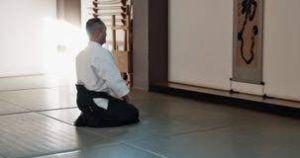
دوجو خواستگاه احترام است:
سنسی و رهبران کلاس شما به راهنمایی همه دانش آموزان در این فرآیندها کمک خواهند کرد.
چون کاراته با احترام شروع می شود و به پایان می رسد…
لیست زیر شامل ترکیبی از فرهنگ کلاس درس ژاپن و آداب پایه کاراته است.
در حالی که برخی از نکات زیر به طور ارگانیک به بلوغ می رسند، برخی دیگر باید فوراً اتخاذ شوند.
دانشآموزان هنگام ورود به محل تمرین در مقابل دوجو تعظیم میکنند و میگویند “Onegaishimasu”، به معنای “لطفا به من بیاموز” یا “لطفا کمکم کن”.
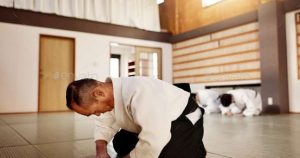
هنگام خطاب به مربی در آموزش، دانش آموزان باید آنها را “Sensei” [معلم] صدا کنند. رهبران طبقات به عنوان “Sempai” به معنای ” ارشد” خطاب می شوند.
یونیفرم کاراته را کاراته گی می نامند و در تمام کلاس ها پوشیده می شود. دانش آموزان باید همیشه نظافت شخصی را رعایت کنند. لباس فرم باید تمیز و مرتب باشد.
همیشه یک بطری آب به کلاس بیاورید.
هنگامی که یک مربی به دانش آموز توصیه یا تصحیح می کند، دانش آموز باید صمیمانه گوش دهد و با “های” (بله) یا “متشکرم” پاسخ دهد.
اگر دیگری در حال دریافت مشاوره است، با دقت گوش دهید – این اصلاح می تواند در مورد شما نیز اعمال شود.
هنگام جفت شدن با دانش آموز دیگر، مودبانه است که هنگام شروع و پایان فعالیت مشترک به یکدیگر تعظیم کنید.
در هنگام خروج از دوجو، دانشآموزان باید رو به جلوی محل تمرین قرار بگیرند، تعظیم کنند و بگویند «آریگاتو گوزایماشیتا»، به معنای تشکر بسیار مؤدبانه.
سوگند دوجو
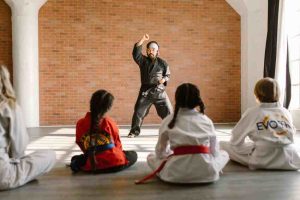
دوجو کان مجموعهای از فضیلتهایی است که دانشآموزان کاراته تشویق به یادگیری آنها میشوند
(مثل چیزی که پیشاهنگان دارند). آنها فلسفه های ساده ای هستند که رشد ویژگی های مثبت فردی و اجتماعی را ترویج می کنند.
برخی از دوجوها این تعهدات را قبل از تمرین می خوانند. ما فقط از شما می خواهیم که آنها را بخوانید، ارزش آنها را درک کنید و سعی کنید آنها را در زندگی روزمره خود به کار ببرید.
لطفاً اینها را با کاراته کا (دانشجوی) خود بخوانید و به جذب این ارزش های شگفت انگیز کمک کنید.
ما هنرجویان کاراته دو تلاش می کنیم تا به این تعهدات عمل کنیم:
1. دوجو مکانی مقدس است که در آن همه چیز با احترام و اخلاق خوب شروع و پایان می یابد.
2. ذهن و بدن خود را طوری تربیت کنید که کمک های مثبتی به خانواده، جامعه داشته باشد و حس اخلاقی خود را پرورش دهید.
3. در راه خود متواضع باشید، مودب باشید و برای رشد شخصیت خوب تلاش کنید.
4. در شور و نشاط جوانی وسواس نداشته باشید، بلکه برای کسب روحیه پیشرفت تلاش کنید.
5. همیشه برای یادگیری و راهنمایی گرفته شوید و به یاد داشته باشید که مانند یک تازه کار بی گناه باشید.
شروع و اتمام یک کلاس کاراته دوجو:
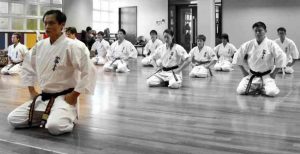
کلاس ها با یک مراسم رسمی شروع و به پایان می رسد که به همه تمرین کنندگان این امکان را می دهد تا با تاریخ و فرهنگ کاراته ارتباط برقرار کنند.
ما از این زمان برای تنظیم مجدد، تأمل، احترام به یکدیگر و قدردانی از گذشته و حال استفاده می کنیم که ارزش های گوجو ریو کاراته دو را به دیگران منتقل می کنند.
دانش آموزان به ترتیب رتبه از چپ به راست، ردیف اول، ردیف دوم و غیره می ایستند.
هر چه دانش آموز با تجربه تر باشد، به سمت راست جلوی دوجو نزدیک تر می شود. سنسی شرکت کنندگان را از طریق شروع و پایان کلاس راهنمایی می کند. دانش آموزان در نقاط خاصی با پاسخ های مودبانه تعامل دارند.
تعظیم در دوجو دست دادن ژاپنی:
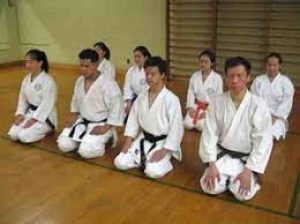
تعظیم معمولاً به عنوان بیان سلام، احترام، عذرخواهی یا قدردانی در موقعیت های اجتماعی استفاده می شود.
این معادل یک دست دادن صادقانه است که در بسیاری از فرهنگ های دیگر استفاده می شود. دو روش برای رکوع وجود دارد: کمان ایستاده و زانو زدن.
کمان بیانگر احترام یا ادب است و بنابراین باید به طور کلی اجرا شود – علاوه بر استفاده از وضعیت صحیح، تنفس و هوشیاری، کمان باید احساس قوی صمیمیت و فروتنی را نیز ایجاد کند.
تعظیم چیزهای بیشتری از خم شدن در ناحیه کمر است.
زمان بندی (چه کسی اول تعظیم می کند)، عمق (چقدر کم تعظیم می کنید)، ارتفاع (ایستادن یا زانو زدن) و دایره واژگان (چه چیزی باید بگوییم) برخی از ملاحظاتی هستند که نشان می دهد تعظیم شما چقدر می تواند محترمانه باشد!
what is dojo?
Basic dojo rules and etiquette
how traditional martial art’s practices empowers students.
Karate was popularised from Japan and as such is inherently filled with the culture’s language, training attire, tools and ethical practices. We feel it is very valuable to include many of these traditions to not only enhance the training experience of students or to foster cultural appreciation, but help them develop self discipline and self respect.
Your sensei and class leaders will help guide all students through these processes.
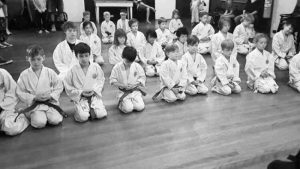
Because karate begins and ends with respect…
The list below includes a combination of Japanese classroom culture and basic karate etiquette. While some of the following points will mature organically, others should be adopted immediately.
-
Students bow to the front of the dojo upon entering the training area and say “Onegaishimasu”, meaning “please teach me” or “please help me”.
-
When addressing the instructor in training, students should call them “Sensei” [teacher]. Class leaders are addressed as “Sempai” which means “senior”.
-
A karate uniform is called a karate-gi and is to be worn at all classes. Students should always maintain personal cleanliness. The uniform must be kept clean and tidy.
-
Always bring a water bottle to class.
-
When an instructor gives a student advice or correction, the student should listen sincerely and respond with a “hai” (yes) or “thank you”. If another is receiving advice, listen intently – the correction could also apply to you.
-
When pairing off with another student, it is polite to bow to each other when you begin and end the joint activity.
-
On leaving the dojo, students should face the front of the training area, bow and say “Arigato Gozaimashita”, meaning a very polite thank you.
Dojo oath
The dojo kun is a set of virtues that karate students are encouraged to learn (sort of like what scouts have).
They are simple philosophies that promote the development of positive personal and social qualities. Some dojo would recite these pledges before training. We simply ask that you read them, understand their value and try to apply them in your daily life.
Please read these with your karateka(student) and help then absorb these wonderful values.
“We, the students of karate-do, strive to fulfil these pledges:
1. The dojo is a sacred place where everything begins and ends with respect and good manners.
2. Train your mind and body to make positive contributions to family, community and cultivate your moral sense.
3. Be modest in your ways, courteous and make efforts for the development of good character.
4. Do not be obsessed with youthful exuberance, but endeavour to acquire the spirit of improvement.
5. Always be taken to learn and guide and remember to remain as innocent as you were as a novice.”
Starting and finishing a class
Classes begin and end with a formal ceremony that empowers all practitioners to feel a connection to the history and culture of karate.
We use this time to reset, reflect, show respect to one another and appreciation to those past and present who continue imparting the values of Goju Ryu karate-do.

Students stand in order of rank from left to right, first row, second row and so on. The more experienced the student, the closer to the front right of the dojo they are positioned. The sensei will guide participants through the commencement and conclusion of the class. Students interact at certain points with polite responses.
Bowing – the Japanese handshake
Bowing is commonly used as an expression of salutation, reverence, apology or gratitude in social situations. It is equivalent to a sincere handshake used in many other cultures. There are two methods of bowing- the standing bow and the kneeling bow.
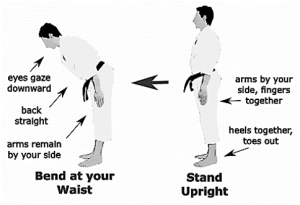
The bow is an expression of respect or courtesy, and therefore it should be executed holistically – in addition to using correct posture,
breathing and consciousness, the bow must also project a strong feeling of sincerity and humility.
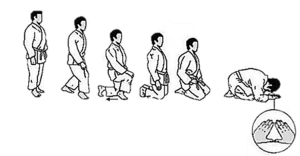
There is more to bowing than simply bending at the waist. Timing (who bows first), depth (how low do you bow),
elevation (standing or kneeling) and vocabulary (what to say) are some of the considerations to how respectful your bow can be!
- LAST news in Martial arts
